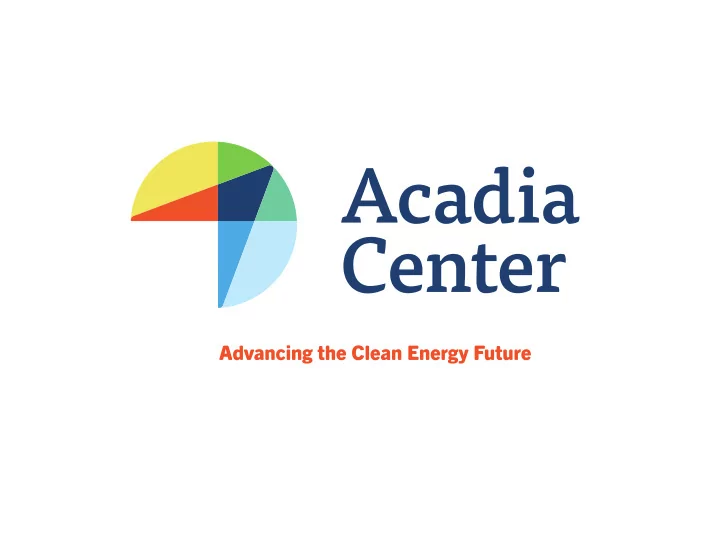

Conference Title Making the Energy System Work for Consumers and the Environment Rhode Island Public Utilities Commission May 14, 2015
ClimateVision2020
Key Trends from ClimateVision2020 1. Power generation emissions down 44%. 2. T ransportation sector accounts for 47% of the region’s total emissions. 3. Oil-heated buildings are hard-to-reach for efficiency programs.
EnergyVision Low Carbon Power + New Electric Technologies = Pathway to Deep GHG Reductions
Pathway to Deep GHG Reductions
Existing Power System: Premised on one-way power flow from large fossil-fueled generators to customers Not designed for high levels of distributed generation, large- scale renewable integration, or high consumer adoption of new energy technologies and strategies.
Changing how we think about the energy system: Putting consumers in the center
Reforms Needed in 3 Key Areas • Coordinated utility planning for the future. • Consumer protection and fair pricing for all. • Updated roles for regulators, utilities, and stakeholders.
Empowering the Modern Energy Consumer • Consumer control • New opportunities • Embrace innovation • Remove barriers to new technologies • Protect consumers • Fair rates
Strategic Planning for a Consumer-Focused Power Grid Grid planning must merge the traditional world of “poles and wires” with available new technologies and modern strategies.
Planning Merges “Poles & Wires” and Distributed Energy Resources “Non - wires” activities in the region
Consumer Voices Critical to Energy System Planning Regulators have strong role in advancing public policy goals and maintaining consumer protections. Stakeholder engagement can close information gap between utility and regulators.
Aligning Utility Incentives with Consumer and Environmental Goals Regulation needs to change to provide utilities with the financial incentives that will achieve consumer & environmental policy goals.
How Consumers Pay for the Power They Use Electric rates should be designed to empower consumers to make smart energy and economic decisions to save money and energy. Principles: 1. Preserve incentive for EE and DG. 2. Protect low income customers. 3. Fair payments for staying connected to the grid and fair compensation for services provided to the grid.
How Consumers Get Paid for the Power They Produce Distributed generation customers should be charged based on the costs of staying connected to the grid and credited for the full range of benefits they provide. Long term vision: 1. Fully reformed retail rates: Time-varying rates for supply. Well-designed demand charges or TVR for delivery. 2. Bi-directional rates for DER: • Fixed charge for metering and billing • Charge for power consumed on time-varying basis. • Credit for power exported on time-varying basis. • Delivery charges for using the grid to consume & export power to the grid, reflecting the costs and benefits of each.
Short Term Recommendations Avoid reliance on fixed charges and minimum bills • Limit fixed charges to metering, billing, and service drop costs. • Consider public policy objectives to lower fixed charges further. • Transparent process and calculation. • Rhode Island currently has minimum bill set at level of fixed charge, but this could be lowered to zero.
Impact of Higher Fixed Charge in RI
Minimum Bill in RI
Short Term Recommendations Reform net metering to better reflect the right values for distributed generation. • Output from DG should be credited for its grid-wide costs & benefits. • Value of avoided energy, capacity, T&D, environmental benefits. • Credit value should reflect the costs of using the grid to consume/export power.
Grid-Value of Solar PV in MA (25 year levelized cost, $2014) 35 Net Social Cost NOx Net Social Cost SO2 30 Net Social Cost CO2 Avoided NOx Compliance Costs 25 Avoided CO2 Compliance Costs DRIPE - Capacity cents per kWh (2014$) 20 DRIPE - Energy Avoided Distribution Costs 15 Avoided Transmission Costs Avoided Capacity Costs Avoided Energy Costs 10 5 0 Grid Value Societal Value
Additional Considerations • The legislative framework for this proceeding is limited to distribution rates but we should be evaluating rate reform in a broader context. • Adjusting net metering credits for west-ward facing solar systems that help reduce peak demand. • Adjusting net metering credits to reflect geographic areas of need, such as system reliability zones (e.g. Tiverton/Little Compton).
Conclusion 1. Rate design should maintain marginal incentives for using energy wisely. 2. Consumers should have the ability to control their energy bills by making smart decisions. 3. In the short run, adjust net metering compensation to fully reflect benefits and costs, including impacts on the grid. 4. In the long run, demand charges and time-of-use rates are options to better align rates for distribution and transmission with cost drivers.
Recommend
More recommend